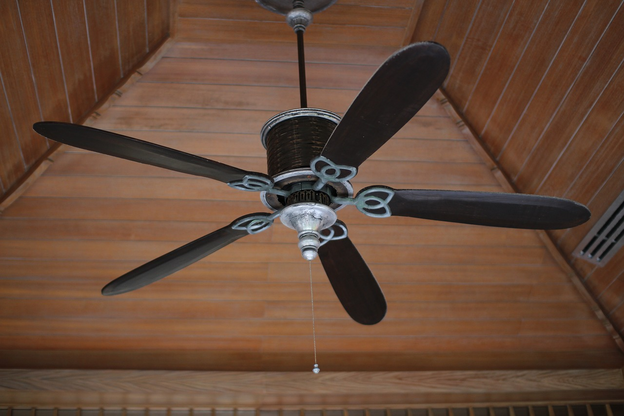
When the weather gets especially cold in the winter, people tend to feel it in more ways than just their bodies. They feel it in their wallet, as keeping your house warmed with your heating unit is not something you can easily do all season long. Also, people often use the heating unit too much because their home allows the heat to escape or be wasted.
For 2022, this pain in the wallet is set to get worse. The Energy Information Administration expects residential electricity costs to rise by 7.5% this year. Gas heating costs are set to soar even higher, driven by the war in Ukraine and rising inflation.
To help avoid wasting money on your heating, we’ve prepared a list of 10 DIY hacks to help keep your home warm without over-rely on your heating unit.
10 DIY Hacks to Save You Money This Winter
#1. Reverse your ceiling fan
Your ceiling fan is not just helpful when it’s warm; it’s also helpful when it’s cold. In most ceiling fans, all you need to do to accomplish this is flip a switch on the fan, which causes the fan to move in reverse. Be sure to turn the light switch on when attempting this hack to be safe. When the fan rotates counterclockwise, it helps circulate cool air; rotating clockwise helps circulate warm air instead.
Some fans may not have switches and instead have remotes that have the functionality. However, note that such a thing may impact your fan’s motor. Additionally, if you can’t access the switch without removing the screws, only do so if you can handle it.
#2. Use an additional heating source
While it may seem counterproductive, using an additional heating source to heat your most commonly used room saves more energy than it uses. A gas vent-free heater is one of your best options if you’re looking to try this.
#3. Use reflective foil to trap heat
If you have a radiator, you can use reflective foil insulation, placing it on the wall behind and above the radiator. This is especially true if the radiator is on an outside wall, as the heat from the radiator often escapes outside.
#4. Insulate windows
Doors and windows are among the most common ways for heat to escape from your home. To keep this from happening, use insulating film on your windows. To learn more about how to use this film, click here. It’s a simple task and only gets more straightforward as you do it more.
#5. Seal an unused fireplace

This can be pretty difficult for many, but if you only rarely use your fireplace, you should consider using it as a purely aesthetic feature. However, you can still seal it up with insulation tape if you want to use it every once in a blue moon. If you use the fireplace, be sure not to use your heating unit simultaneously, as the fireplace can draw heat up the chimney.
#6. Replace your filters
When a filter is left dirty, it has multiple repercussions for you and your home. Besides potentially making your air quality lower, it also causes your furnace to have to work harder as a result. Be sure to clean your filters regularly and replace them with new ones when needed. If necessary, consider paying for a furnace inspection, as leaving these problems untreated can become more costly.
#7. Get a smart thermostat
This one requires a little technical know-how to set up, but more than anything on this list, it best enables you to control your utility costs. To set it up, follow the user manual with your respective smart thermostat. The method of setting up may vary, so be sure to do research into that before you choose a thermostat.
The thermostat allows you to do many things to better manage the temperature. For example, many smart thermostats have smartphone apps that can connect to them, allowing you to control the temperature remotely. So, for instance, if there is a freak blizzard while you’re away on holiday, you can bump the temperature up.
However, one of the best features is that you can put the smart thermostat on a schedule. For example, you can tell it to turn the temperature down while you’re at work and turn it up when you’re home. You can also have the temperature automatically increased at night but decreased during the day.
#8. Close off vents to unused rooms
Not all rooms may need heating at all times, so an excellent way to keep heating costs down is to turn the thermostats down. However, be sure to close off the vents to these rooms. Otherwise, the heat will leak in.
#9. Check for drafts

If you’re trying to keep your home draft-free, a candle or lighter is the best tool to find them. Hold an open flame up to areas where the heat may escape, like a window or door, and see if the flame flickers. If it does, you need to seal it off using weather stripping or caulk (in the case of cracks).
#10. Use your curtains effectively
Curtains are a surprisingly helpful tool, both closed and open, during the winter. Using long curtains over your windows can more easily keep the cold from getting in. Particular curtains such as polyester will also be more effective at keeping the cold out.
Another essential thing about curtains is that they should be kept open on sunny days. While it is still cold outside, the sun is a natural heat source and helps keep your rooms a little warmer than they would be otherwise. Another thing you can do to help keep cold from entering through the tops of the curtains is to stuff paper towels along the curtain rod.
Ref: 3124.27181




 POSTED BY
POSTED BY 

